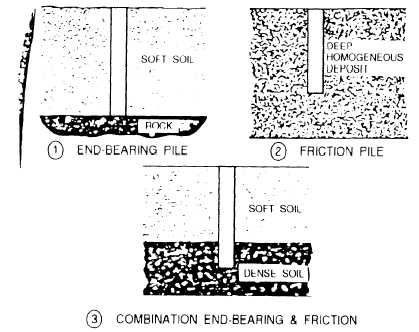Figure 12-74.—Types of bearing piles.
fairly soft soil that provides frictional resistance and
then into a form layer which develops a load-carrying
capacity by both end bearing and friction over a rather
short length of embedment (fig. 12-74).
7. Batter piles. Piles driven at an angle with the
vertical are called batter piles. They resist lateral or
incline loads when such loads are huge or when the
foundation material immediately beneath the structure
fails to resist the lateral movement of vertical piles.
They also may be used if piles are driven into a
compressible soil to spread vertical loads over a large
area thereby reducing final settlement. They may be
used alone (battered in opposite directions) or with
vertical piles.
8. Anchor piles. An anchor pile may be used to
anchor bulkheads, retaining walls, and guy wires. They
resist tension or uplift loads (fig. 12-75).
9. Dolphin piles.
As shown in figure 12-75,
dolphin piles are a group of piles driven close together
in water and tied together so that the group will
withstand lateral forces, such as boats and other floating
objects.
10. Fender piles. As shown in figure 12-75, fender
piles are driven in front of a structure to protect it from
damage.
11. Foot of pile. As shown in figure 12-75, the foot
of a pile is the lower end of a driven pile, which is the
smaller end.
12. Guide piles. Piles used as a guide for driving
other piles or serving as a support as a wale for
sheetpiling.
13. Pile bent. Two or more piles driven in a row
transverse to the long dimension of the structure and are
fastened together by capping and (sometimes) bracing.
14. Pile foundation. A group of piles used to support
a column or pier, a row of piles under a wall, or a number
of piles distributed over a large area to support a mat
foundation.
15. Pile group. A number of bearing piles driven
close together to form a pile foundation.
16. Test piles. A pile driven to determine driving
conditions and probable required lengths; one on which
a loading test may also be made to find its load
settlement properties and the carrying capacity of the
soil and as a guide in designing pile foundations.
17. Timber piles.
Common timber piles are
usually straight tree trunks cut off aboveground
swell, trimmed of branches, and the bark removed.
A good timber pile has the following charac-
teristics:
• It is free of sharp bends, large or loose knots,
splits or decay.
• It has a straight line between centers of the butt
and tip and lies within the body of the pile.
• It has a uniform taper from butt to tip.
12-52


